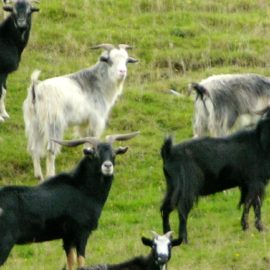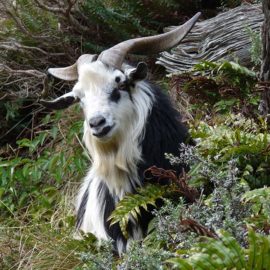 Introduction
Introduction
Goats were introduced to New Zealand in the early days of European settlement for food, to establish a commercial fibre industry, and for weed control on developing land. The descendents of those that escaped or were deliberately released thrived in the country’s grass hills, forest and scrubland areas. To date we have dispatched over 5,000 goats. This has resulted in our habitat and understory improving. This is essential to provide our kiwi and kokako with an environment which they can thrive in.
They can be white, brown or black, or any combination of these. In New Zealand both sexes have horns. All males and some females are bearded as adults. Males are the largest sex, with clearly heavier forequarters, shaggier coats and larger horns.
Feral goats are found in a wide range of habitats. They range from sea level to the alpine zone, living in introduced and native grasslands, scrub and forest.
The Threat
 Because they are browsers, their preferred habitat is forest or scrub-covered upland containing areas of grassland. They are agile on steep crags and narrow ledges and can get to areas that deer can not reach. They like sunny sides of slopes, making use of open places close to the shelter of forest or scrub.
Because they are browsers, their preferred habitat is forest or scrub-covered upland containing areas of grassland. They are agile on steep crags and narrow ledges and can get to areas that deer can not reach. They like sunny sides of slopes, making use of open places close to the shelter of forest or scrub.
New Zealand’s native plants are particularly vulnerable to damage from browsing. Herding browsers such as goats cause two-fold damage by eating native plants and by trampling large areas of vegetation and compactable soils.
Goats will eat the foliage of most trees and plants and quickly destroy all vegetation within their reach, eating seedlings, saplings and litter-fall off the forest floor. They do however have strong preferences and will eat out favoured species first such as broadleaf/papauma (Griselinia littoralis) and mahoe (Melicytus ramiflorus) before moving on to less desirable plants. Goats will also strip bark off trees and by eating young seedlings they effectively put a stop to forest regeneration.
